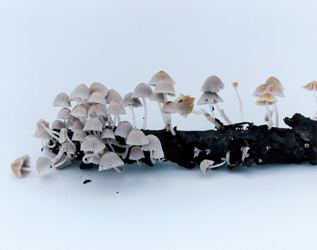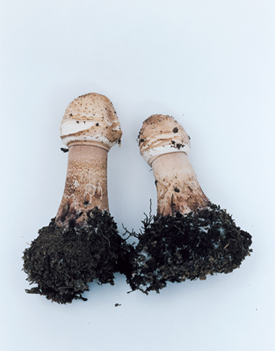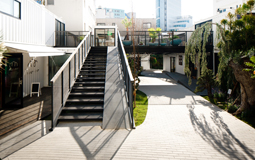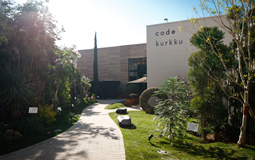 |
Focus features two in-depth reviews each month of fine art, architecture and design exhibitions and events at art museums, galleries and alternative spaces around Japan. The contributors are non-Japanese art critics living in Japan. |
|
|
 |
 |
 |
Message in a Mushroom: Takashi Homma at Blind Gallery
Lucy Birmingham |
 |
 |
|
 |
Takashi Homma, Mushrooms from the Forest 2011 #14, C-print,
267 x 337 mm, 2011 |
|
Takashi Homma, Mushrooms from the Forest 2011 #8, C-print,
267 x 337 mm, 2011 |
A mushroom, is a mushroom, is a mushroom . . . right? Not necessarily. The diminutive fungi can be an empowered symbol of health, food safety, and even the anti-nuclear energy movement -- if "empowered" by radiation, that is. Photographer Takashi Homma spotlights the tragic consequences of the Fukushima nuclear plant accident on forests, nature, and the food chain with 22 images of locally picked fresh and fleshy irradiated mushrooms. Mushrooms from the Forest 2011, his exhibition at the newly opened Blind Gallery in Tokyo's Yoyogi Village, is showing until January 29.
Although Homma is known for his urban scenes and portraits of children and the elderly, he's been interested in mushrooms for a long time. There are few examples of photos of wild varieties because they quickly decay after picking. Producing images of fresh mushrooms requires immediate, on-site photography.
Homma's interest was piqued when he learned that the fungi easily absorb radiation and thrive in areas contaminated by radiation disasters. With Geiger counter in hand and a local guide, Homma ventured into the thick Fukushima forests last fall, carefully picking about 100 specimens from the trunks and bases of trees. There in the forest, he set up a mini-photo studio to capture his fresh findings. (Measuring radiation levels in mushrooms is a good indicator of the conditions of the surrounding soil, air and water.)
The photos reveal not only Homma's interest in irradiated mushrooms, but the forest as a whole. Although a source of air we breathe and a giver of life, once irradiated a forest becomes a virtual death trap: necessary to humankind, but here in Homma's work, invisibly destroyed by the folly of human technology.
Invisibility is key to the gallery's theme. With this inaugural show, there is a dark double entendre. "The Blind Gallery name suggests invisible value," explains gallery director Yusuke Nakajima. "Through art, you can attain valuable messages and inspiration in ways other than visual." The gallery hopes to offer an ambitious selection of bimonthly exhibitions of works for sale and accompanying catalogues. (Fine prints of Homma's mushroom photography and a catalogue of the show can be purchased.)
 |
|
 |
Takashi Homma, Mushrooms from the Forest 2011 #12,
C-print, 267 x 337 mm, 2011 |
|
Takashi Homma, Mushrooms from the Forest 2011 #20, C-print, 590 x 393 mm, 2011 |
Nakajima fittingly chose Homma's conceptual photos for both the gallery and the new Yoyogi Village retail/restaurant complex, where it's located. The photo exhibit, and the Village itself, reflect the efforts of a small group of eco-sustainability and shoku-iku ("meal education") entrepreneurs -- some of Japan's music industry movers and shakers, along with designers, event producers, chefs and "green" believers. "When you eat something good [and healthy], you understand how precious nature is," says Ken Masui, who oversees the Village events and planning. "That's why we're practicing shoku-iku here. It's opening people's eyes."
Masui works mainly as head of international relations for music producer and ecology advocate Takeshi Kobayashi. The brains and creative genius behind Yoyogi Village, Kobayashi juggles an astounding stream of businesses and eco-projects. His main company, Oorong-sha, produces the mega-popular rock group Mr. Children. AP (Artist Power) Bank is the CSR division that supports NGOs and offers microfinancing for environmental projects. Collaborators on this venture include famed musician Ryuichi Sakamoto and Mr. Children lead singer Kazutoshi Sakurai. The Food Relation Network division includes Kurkku restaurants and promotes healthy foods and culture.
A Kurkku restaurant and music bar are located within Yoyogi Village. Chef Yasuhiro Sasajima oversees the restaurant with an organic focus and gourmet flavors -- including non-irradiated mushrooms. The bar has a captivating music selection by musician, producer and DJ Shinichi Osawa. Retail businesses include the Roots & Beat Coffee cafe using fair trade beans from Tanzania (and no child labor); eco-tour agency Love, Peace, Travel by H.I.S.; Post bookstore, which features gallery-style "shows" of publishers' works; and One Mile Wear clothing, offering chemical-free, pre-organic cotton from farms in India (with guaranteed financing).
The Village is in a quiet enclave -- a three-minute walk from Yoyogi Station on Tokyo's Yamanote loop line -- conveniently located between the busy Shinjuku and Shibuya districts. Incorporating refurbished shipping containers into retail spaces, interior designer Masamichi Katayama worked his cool style throughout the complex, which opened last November. Landscaping by Seijun Nishihata features his choice of plants from across the globe.
Homma's irradiated mushrooms serve up a fitting introduction to Japan's growing grass roots movement toward organic, non-nuclear sustainability. With the backing of artists, musicians, and creative entrepreneurs even something as small as a mushroom can pack a powerful message.
 |
|
 |
Yoyogi Village, Tokyo, a retail/restaurant complex with an eco-sustainability and healthy food/lifestyle theme
|
|
The entrance to Code Kurkku restaurant in Yoyogi Village
All images courtesy of Blind Gallery
|
|
|
|
 |
Takashi Homma: Mushrooms from the Forest 2011 |
 |
Blind Gallery |
 |
17 December 2011 - 29 January 2012 |
|
|
|
|
 |
 |
Lucy Birmingham
Based in Japan for almost 25 years, Lucy Birmingham has written for Newsweek, Bloomberg News, Architectural Digest, The Boston Globe, Artinfo.com, Artforum.com, and ARTnews, among other publications. As a photojournalist her work has appeared in The New York Times, Business Week, Forbes, Fortune, U.S. News and World Report, and A Day in the Life of Japan. She is also a scriptwriter and contributing editor at NHK, Japan's public broadcaster, and has published several books including Old Kyoto: A Guide to Traditional Shops, Restaurants, and Inns. |
|
 |
|